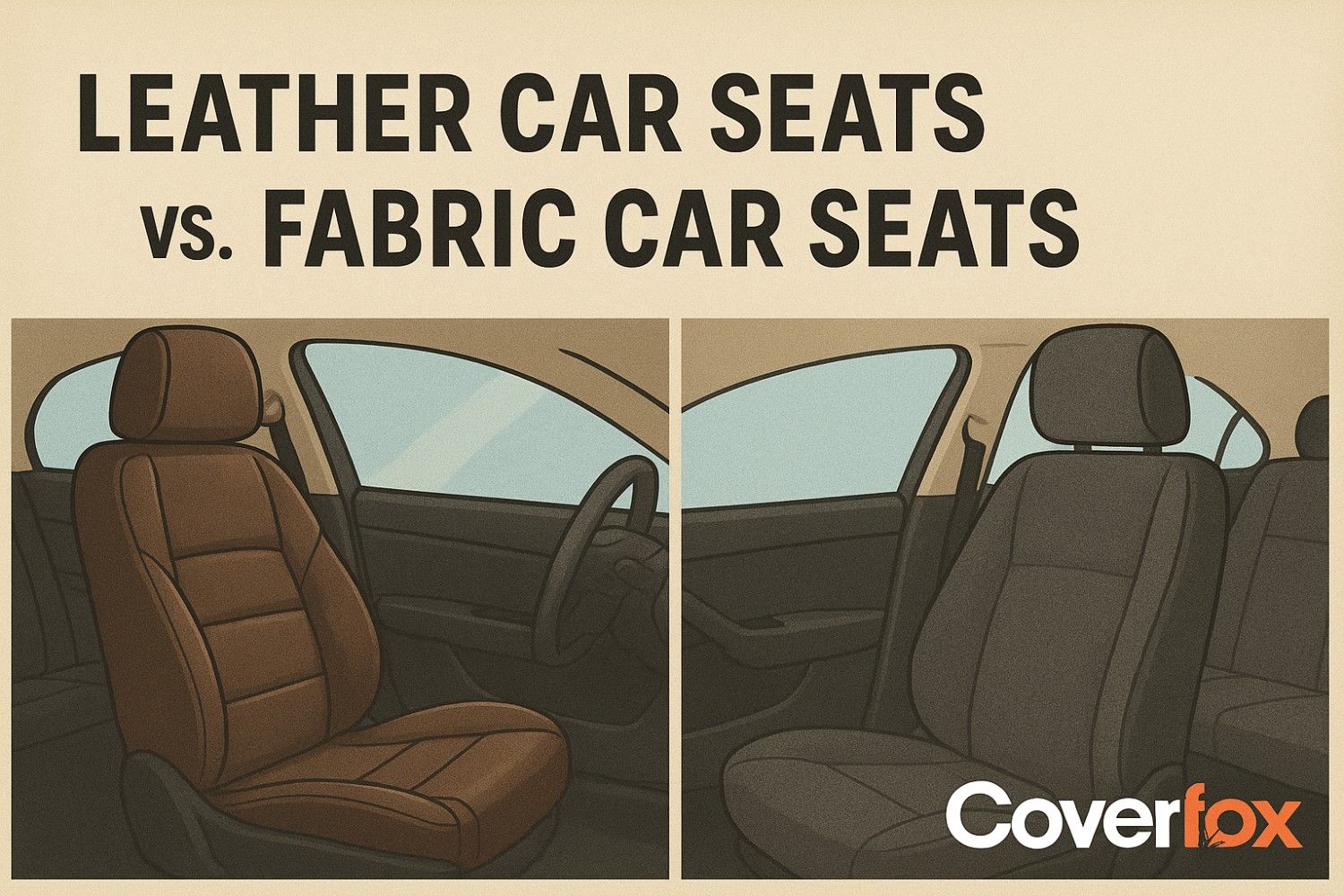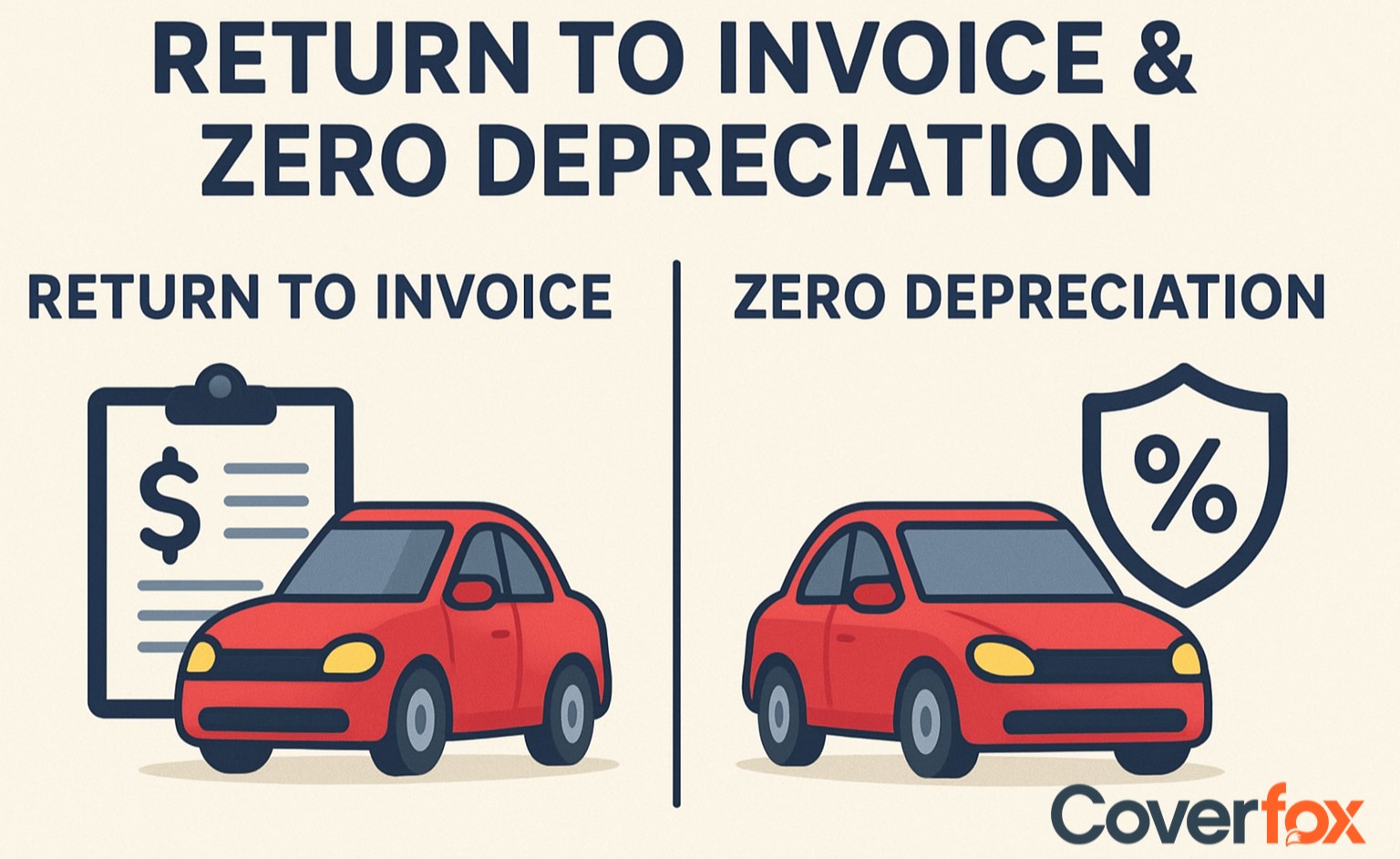As you enter a car and take a seat, the seat’s covering will decide how your entire journey will be. If not the right type, you might feel irritated or uncomfortable. That’s why, many people invest in top-notch car seat coverings, be it leather or fabric.

But which one will suit you the best? To get the answer to that question, read on!
Why Your Car Seat Material Matters
The material of your car seats affects comfort, durability, and overall driving experience. Choosing the right one can make your daily commute more enjoyable and easier to maintain through:
Comfort
Durability
Maintenance
Safety
Resale Value
Fabric seats are soft and breathable, while leather offers a premium feel but can get hot or cold depending on weather.
Vinyl and synthetic materials resist wear and tear, making them ideal for long-term use.
Leather requires regular conditioning; fabric may need frequent cleaning to avoid stains.
Seats with better grip reduce sliding during sudden braking, keeping you securely in place.
Premium materials like leather can increase your car’s resale appeal.
Understanding Leather Car Seats
Leather car seats are known for their luxurious look and smooth feel, enhancing your vehicle’s interior. They are durable, easy to clean, and resistant to spills, but can get hot in summer and cold in winter. Regular conditioning is needed to prevent cracks and maintain their premium finish. Leather seats also tend to increase the car’s resale value due to their high-end appeal.
Advantages of Leather Car Seats
Leather seats offer a blend of luxury, comfort, and durability for your car interior:
- Enhances the car’s premium look
- Easy to clean and maintain
- Durable and long-lasting
- Comfortable for long drives
- Increases resale value
Drawbacks of Leather Car Seats
While leather seats are luxurious, they come with certain challenges that may affect comfort and maintenance.
- Expensive compared to fabric seats
- It can get very hot in summer and cold in winter
- Requires regular conditioning to prevent cracks
- It can be slippery, offering less grip
- Prone to scratches and damage from sharp objects
Care for Leather Seats
While these luxurious seats definitely are an eye catcher, they do need to be maintained regularly:
- Clean regularly with a soft, damp cloth to remove dust and spills
- Use a leather conditioner every few months to prevent drying and cracking
- Avoid direct sunlight for prolonged periods to prevent fading and heat damage
- Wipe off spills immediately to prevent stains
- Use seat covers if transporting pets or sharp objects to protect the leather
Understanding Fabric Car Seats
Fabric car seats are made from woven textiles, offering a comfortable and breathable seating option. They are soft, ideal for long drives, and remain relatively cool in hot weather. Fabric seats are versatile, affordable, and available in various colours and patterns to match your car’s interior.
Advantages of Fabric Car Seats
Comfort is the main objective of a fabric seat, and its advantages include:
- Soft and comfortable for long drives
- Breathable, keeping seats cooler in summer
- Affordable compared to leather seats
- Available in a variety of colours and patterns
- Less slippery, providing better grip while driving
Drawbacks of Fabric Car Seats
Whilst they are comfortable, they also have some limitations like:
- Can stain easily from spills and dirt
- Absorbs odors and requires regular cleaning
- Less premium look compared to leather
- Prone to wear and tear over time
- Harder to wipe clean quickly
Care for Fabric Car Seats
Just like leather seats, you do need to take care of fabric seats as well. You can do so by:
- Vacuum regularly to remove dust and debris
- Clean spills immediately to prevent staining
- Use fabric-safe cleaners for deep cleaning
- Avoid prolonged exposure to direct sunlight to prevent fading
- Consider seat covers to protect against wear and tear
Differences between Leather Car Seat and Fabric Car Seat
While leather car seats are more on the premium end, fabric car seats also cover up through its comfort. This table indicates where a leather car seat prevails and where a fabric one prevails:
| Aspect | Leather Car Seats | Fabric Car Seats |
|---|---|---|
| Durability and Wear Over Time | Highly durable, resists spills and stains, but can crack, fade, or peel if not conditioned | Prone to stains, fading, and wear over time, but does not crack or peel |
| Comfort | Smooth and soft, but can get hot in summer and cold in winter | Breathable and stays relatively cool, comfortable for long drives |
| Maintenance | Requires regular cleaning and conditioning to maintain appearance | Easy to clean with vacuuming and fabric cleaners, minimal upkeep |
| Grip and Safety | Slippery surface can cause sliding during sudden braking | Provides better grip, reducing sliding and enhancing safety |
| Aesthetics | Premium and luxurious look, enhances car resale value | Casual and practical look, available in various colours and patterns |
| Price Considerations | Higher upfront cost, usually in premium trims, occasional repair/reconditioning may be needed | Lower upfront cost, widely available across trims, cheaper to clean and maintain |
| Climate Adaptability | Sensitive to extreme heat or cold, may require seat covers or sunshades | Adapts better to hot climates, stays comfortable without additional accessories |
| Longevity | Can last many years if well-maintained | May wear out faster but generally low-cost to replace |
| Environmental Considerations | Leather production has higher environmental impact | Fabric is generally more eco-friendly, especially synthetic or recycled options |
Final Thoughts
Choosing between leather and fabric car seats comes down to balancing comfort, durability, maintenance, and budget – just like choosing a car insurance policy. Leather offers a premium look and long-term durability but requires upkeep and can be sensitive to temperature extremes. Fabric is breathable, comfortable, and easier to maintain day-to-day, though it may wear faster and stain more easily. Experiencing both options in real-world conditions helps you understand how each feels during daily driving and ensures your choice suits your lifestyle, climate, and long-term needs.
Also Read:
How Advanced Blind Spot Mirrors Improve Your Safety on the Road?
A Complete Guide to Replace Your Car Key Battery
Car Modifications in India: Legal and Illegal Customisations
Frequently Asked Questions
Which is better, leather or fabric seats?
It depends on your priorities—leather offers a premium look and durability, while fabric is more comfortable, breathable, and easier to maintain in hot climates.
How long do leather seats last?
With proper care and regular conditioning, leather seats can last 8–15 years or more without significant wear.
Can I upgrade from fabric to leather later?
Yes, many vehicles allow aftermarket leather seat covers or full seat upholstery upgrades, though costs and fit may vary.
Are leather seats worth the extra cost?
Leather seats are worth it if you value luxury, durability, and higher resale value, but they require more maintenance and may be affected by extreme weather.
Which seat material is best for Indian weather?
Fabric seats are generally more suitable for Indian weather due to their breathability and ability to stay cooler in hot climates, though leather with proper sun protection can also work.





